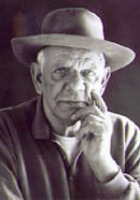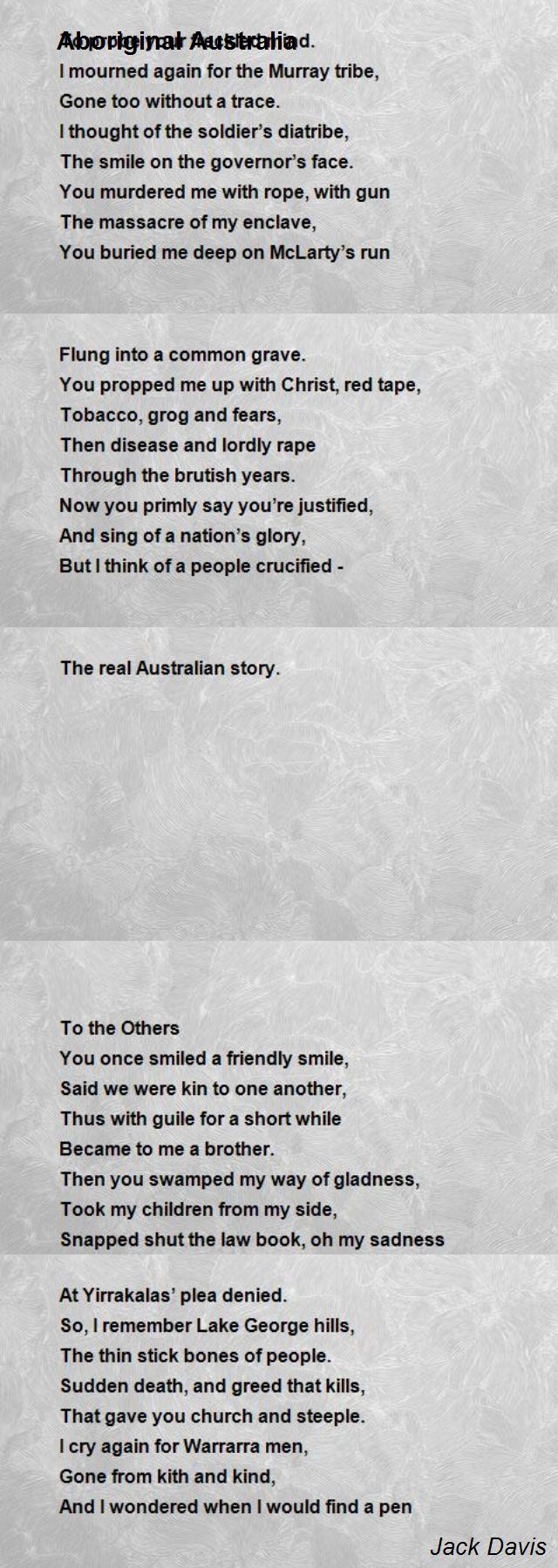Black Life Poems Jack Davis
- Black Life Poems Jack Davis Jr
- Jack Davis Art
- Black Life Poems Jack Davis Death
- Black Life Poems Jack Davis Son
- Jack Davis Attorney
- Jack Davis Artwork
- Jack Davis Cartoons
JackDavis has a particularly complex relationship with the landscape. It is basedon his connection with the land as traditionally understood by his people: aconnection Davis had to rediscover as a young man, after his family had beenrelocated to Perth from northern Western Australia. In addition, his years as astockman in the north have broadened his view of the land as a resource. Thatis, he also sees the land as someone who has earned a living from it (in theEuropean sense), and has survived in some of Australia’s harshest terrain, bothas someone trained in Aboriginal ways of using and living on the land, and asan employee of white pastoralists.
Site: 8 Chifley Square, Sydney April 28, 2014– Text: “Caterpillar Tractor” by Katakapu, English translation by Alexander Brown and Brian Geytenbeek, © 2003 the.
Thisgives him a unique insight into European agricultural uses of the land, andinto the attitudes of the white stockmen with whom he worked. European conceptsof living on (or rather, off) the land are strikingly different to the valuesof Aboriginal communities, with which Davis has a political affinity. Althoughboth are linked to the concept of the land as a resource, this is understood invery different ways.
JackDavis has seen the destruction of the land by the farmers and foresters, andhas also felt the belonging that he tries to explain in some of his earlypoems.
- Www.PoemHunter.com - The World's Poetry Archive 2 Jack Davis (1917 - 17 March 2000) Jack Davis, was a notable Australian 20th Century playwright and poet, also an Indigenous rights campaigner. Born in Perth in 1917, Jack spent his childhood in Yarloop about 140 kilometres to the south. Jack always had a.
- Jack Davis was an Australian poet and playwright who fought for Indigenous rights in Australia throughout his lengthy career as both an activist and an artist. He wrote many poems and plays throughout his career and is celebrated as an innovative theatrical voice, who infused compelling dramas with.
Thisis perhaps best seen in ‘Day Flight’ (6), which illustrates his ways of seeingthe country to which he belongs. It describes his flight in a plane over theland, giving him a chance to see his country from above. Instead of looking outof the window, he closes his eyes and describes the land as he sees it withinhim. He is able to perceive the whole country, from the sky to sea to rivers tolakes to desert, with his eyes closed.
Hisdescriptions are of a land that is valued as his mother, that protects him,that is his home:
And most I longed for, there as Idreamed,
A square of the desert, stark and red,
To mould a pillow for a sleepy head
And a cloak to cover me
Davisacknowledges that the desert can be difficult and harsh, but does not see it(as white writers often do) as hostile and inhospitable. In fact, he seemsuncomfortable at being out of touch with the land, hundreds of metres above it.This is exactly the view of the land conveyed by the artists of several WesternDesert and Kimberley communities, although this ‘satellite’ visual map of thecountry is a form which preceded the ability to view the ground from the air bymany centuries.
Inseveral other poems, Davis attempts to explain this sense of belonging, and tosing the praises of his country. In ‘Land’ (7), he clearly asks:

Black Life Poems Jack Davis Jr
oh white man
how can I make you understand
this love of land?
Howindeed? He does his best. Through the use of both emotive language and simplerhetoric, he describes his love of land as a relationship which is like that ofa mother and her child:
Jack Davis Art
It has the touch of a child’sfingertips
to a mother's lips.
Theland as a source is here given a much more fundamental meaning: that of thesource of the people, parent of all who live within and relate to her as(dependent) children. It is also described in almost clichéd terms as a belovedone (“her loveliness is summer red”). The land is an almost human force, inparticular, a womanly force, who is ever present, day and night, and dwellseven in the stars as the mother of “a black nation’s dreamtime”.
Thisvision is also explored in‘Soul’(8), in which the land is described again as a woman, a lover, a healer, aprovider, and as a contradictory combination of all things. Above all, she isan essential part of the poet, and his romantic poetry:
Sheis my soul, this land of mine.
Thebelonging is a two-way process; each belongs to, and is part of, the other, andis sustained by the relationship. This relationship, in turn, sustains bothcountry and people in their experience of the European invasion.
Inpoems such as ‘The Executioner’ (9) and ‘Red Gum and I’ (10), Davis illustrateshis empathic relationship with the land and its native flora and fauna, in theface of destruction. In ‘The Executioner’, he expresses a sense of solidaritywith the felled tree, in clipped, sharp tones that reflect both the speed withwhich thousands of years of growth can be wiped out, and also theshort-sightedness of the exploiters:
Black Life Poems Jack Davis Death
Material might
Kills—mauls ...
While tree and I
Together bleed.
Heis also contrasting the European view of the land as an economic resource, thetree as income, while the poet (an Aboriginal persona) sees the tree as part ofa more complex system, linked with his own survival and exploitation. In ‘TheRed Gum and I’, Davis goes even further, into the private world of the earth,escaping from the “dirty white…glib tongues…fears and promises…platitudes andHells”.
Incontrast to the promises of Christian salvation offered by white missionaries(now acknowledged as a source of a great deal of intentional culturalcolonisation), Davis suggests that real sanctuary can only be found inunspoiled nature. The imagery is often quite violent, tormented, as he pleasfor salvation which contrasts to the
Fears and promises like worms
That twist and churn within my mind,

Enter my brain, then out again.
Theimagery here reflects the violence being done to the tree, to the country, andto its people. Davis uses the tree to symbolise the centuries-old traditions hesees being destroyed by the onslaught of a homogeneous European culture, aswell as the actual physical violence committed against his people.
Itis partly imagery derived from Christianity’s own culture (hell is hardly apleasant concept) and use of suffering and physical pain as symbols ofspiritual life before salvation. But the “promises” are seen as threats,compared to the deep-rooted traditions of life-long belonging which continuebeyond physical death.
Black Life Poems Jack Davis Son
Davis has been thesubject of mixed critical reaction, and has never achieved the widespreadpopularity of Oodgeroo, although he is perhaps better known in his home state,and better known as a playwright than a poet. But the integration of his livesas a writer, as a spokesperson for his community, and as a patron of therapidly developing Aboriginal arts sector in Western Australia, ought not to beunder-estimated. In particular, although famous for his works in English, heinitiated the reconstruction of his endangered language, Bibbulmum, a symbolicpart of the rebuilding of linguistic and cultural traditions amongst Aboriginalpeople in Western Australia.
Like many other modernAboriginal poets, his work as a poet is inseparable from his other politicaland cultural work. The sense of land and the politics of landscape are inherentand potent in his poetry.
Jack DavisAM,BEM (11 March 1917 – 17 March 2000) was an Australian 20th-century playwright and poet, and an Indigenous rights campaigner. He was born in Western Australia, in Perth, and lived in Fremantle towards the end of his life. He was of the AboriginalNoongar people, and much of his work dealt with the Indigenous Australian experience.
Although Davis composed many of his poems while working as a stockman in the Gascoyne in his twenties, his first volume of poetry was not published until 1970.[1] He has been referred to as the twentieth century's Aboriginal Poet Laureate, and many of his plays are on Australian school syllabuses.
Davis received the Medal of the Order of the British Empire (BEM) in 1976,[2] and a Member of the Order of Australia (AM) in 1985.[3]

- 1Works
Works[edit]
Plays[edit]
- Kullark (1972)
- The Dreamers (1982)
- No Sugar (1985)
- Honeyspot (1985)
- Moorli and the Leprechaun (1986)
- Burungin (1988)
- Plays from Black Australia (1989)
- In your Town (1990)
Jack Davis Attorney
Poetry[edit]
- The First-born and other poems (1970)
- The Black Tracker (1970)
- Jagardoo : Poems from Aboriginal Australia (1978)
- John Pat and Other Poems (1988) Publisher Dent Australia ISBN0-86770-079-3
- Black Life : poems (1992)
Other works[edit]
- Jack Davis : A life-story (1988)
- A Boy's Life (1991)
- Paperbark : A Collection of Black Australian Writings (1992)http://www.uqp.uq.edu.au/book.aspx/147/Paperbark-%20A%20Collection%20Of%20Black%20Australian%20Writing
References[edit]
- ^'MAGAZINE: BOOKS'. The Canberra Times. 63 (19, 443). Australian Capital Territory, Australia. 31 December 1988. p. 17. Retrieved 13 August 2016 – via National Library of Australia.
- ^'Jack Davis'. honours.pmc.gov.au. Retrieved 16 June 2019.
- ^'Jack Leonard Davis'. honours.pmc.gov.au. Retrieved 16 June 2019.